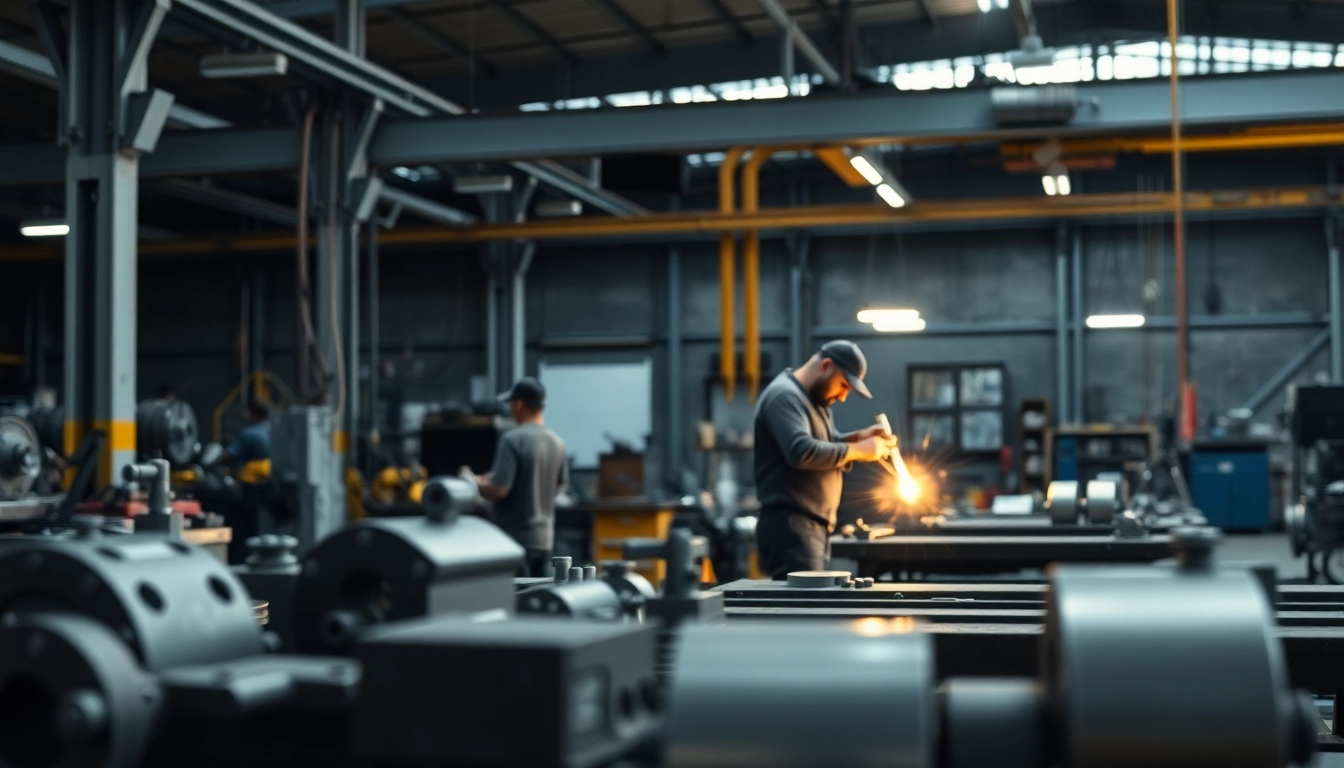
Understanding the Basics of Steel Fabrication Shop
Definition and Importance of a Steel Fabrication Shop
A steel fabrication shop is a specialized facility engaged in the transformation of raw steel materials into various finished or semi-finished products. This process is paramount in numerous industries, including construction, automotive, and shipbuilding. The importance of such shops lies not only in their ability to produce essential components but also in their role in enhancing efficiency, reducing costs, and maintaining quality standards across various applications.
Steel fabrication is crucial for building infrastructure and machinery that are integral to our daily lives, from bridges to skyscrapers and manufacturing equipment. The trade itself combines science and art, requiring a detailed understanding of engineering principles, material characteristics, and precise skills in handling machinery.
Key Processes in Steel Fabrication
The processes involved in a steel fabrication shop can be broadly categorized into three main phases: cutting, bending, and assembling steel materials. Each of these steps is critical to ensuring that the final product meets the exact specifications required by clients.
- Cutting: This process involves breaking down large steel sheets or sections into manageable pieces. Techniques such as sawing, shearing, and plasma cutting are commonly employed, depending on the thickness and type of steel being processed.
- Bending: After cutting, the steel pieces often need to be bent or shaped to meet project requirements. Machines like press brakes and roll benders are used to achieve these shapes accurately. The bending process must consider the material’s yield strength to avoid damaging the steel.
- Assembling: Once the components are cut and shaped, they are joined together through welding or fastening methods. It’s crucial that assemblies maintain structural integrity and meet or exceed safety standards.
Materials Used in Steel Fabrication
Steel fabrication primarily utilizes various grades and types of steel, each chosen based on the intended use of the final product. Common materials include:
- Mild Steel: Known for its malleability and toughness, mild steel is versatile and widely used in construction.
- Stainless Steel: Corrosion-resistant and durable, stainless steel is commonly used in environments where hygiene or weather resistance is necessary.
- Structural Steel: This includes beams, columns, and plates specifically designed for construction applications, providing stability and support.
- Tool Steel: A high carbon steel that is hard and durable, tool steel is used to create cutting tools and dies.
Essential Machinery and Tools in Steel Fabrication Shop
Overview of Cutting and Forming Equipment
To carry out cutting and shaping tasks efficiently, a steel fabrication shop must be equipped with the right machinery. Some essential equipment includes:
- Band Saws: Ideal for precise cutting of various metal thicknesses.
- Laser Cutters: These utilize focused laser beams for intricate cuts and are especially useful for complex designs.
- Press Brakes: A vital tool for bending metal sheets by applying force to create sharp angles or curves.
- Plasma Cutters: Utilizing a high-temperature plasma arc, these cutters are effective for cutting thicker materials quickly.
Welding Technology Used in Steel Fabrication
Welding is a critical process in steel fabrication, providing the means to join metal parts securely. Various welding techniques are employed, including:
- MIG Welding: Metal Inert Gas welding uses a continuous wire feed and is effective for joining thin sheets of steel.
- TIG Welding: Tungsten Inert Gas welding is known for its precision and ability to weld both thin and thick materials.
- Stick Welding: A versatile method that can be used on rusty or dirty surfaces, stick welding is common in fieldwork.
Innovations in Fabrication Tools and Machines
Recent advancements in technology have significantly transformed the steel fabrication industry. Automated CNC (Computer Numerical Control) machines are becoming more prevalent, enhancing precision and efficiency while reducing human error. Other innovations include predictive maintenance systems that use IoT sensors to track machinery performance, thereby minimizing downtime. Additionally, the integration of augmented reality (AR) for training welders is making the learning process more engaging and effective.
Safety Standards in a Steel Fabrication Shop
Common Hazards in the Steel Fabrication Environment
Working in a steel fabrication shop comes with inherent risks, making safety a top priority. Common hazards include:
- Physical Hazards: These include equipment malfunctions, falls, and electric shocks.
- Chemical Hazards: Exposure to fumes and dust from welding and cutting can pose respiratory risks.
- Noise Hazards: Operating heavy machinery can lead to hearing impairment if protective measures are not adhered to.
Implementing Safety Protocols
Establishing robust safety protocols is essential for mitigating risks. Key measures include:
- Regular Safety Audits: Conducting audits to identify potential hazards and remediate them promptly.
- Protective Equipment: Providing personal protective equipment (PPE) such as helmets, gloves, eye protection, and hearing protection.
- Clear Signage: Installing safety signs and providing clear instructions throughout the facility.
Training Workers for Safety Compliance
Training employees on safety protocols is not just a legal requirement but a culture builder in the shop. Training should encompass:
- Onboarding Programs: New employees should receive comprehensive training on safety practices upon hiring.
- Regular Refresher Courses: Ongoing education on safety guidelines helps keep awareness top of mind.
- Hands-on Workshops: Practical training sessions ensure that workers can apply safety protocols in real scenarios.
Quality Control Processes in Steel Fabrication Shop
Defining Quality Standards for Steel Products
Quality control is essential in steel fabrication to guarantee that products meet industry standards and client specifications. Standard quality measures include:
- Material Inspections: Verifying the integrity and properties of steel before fabrication.
- Dimensional Checks: Ensuring that all components meet specified dimensions and tolerances.
- Welding Inspections: Assessing weld quality through visual inspections or non-destructive testing methods.
Inspection Techniques and Tools
Effective quality control utilizes various inspection techniques to assess the quality of products. Common methods include:
- Visual Inspections: Observing surfaces for defects and irregularities is the simplest yet essential quality check.
- Ultrasonic Testing: This method uses sound waves to detect internal flaws in the material.
- X-ray Inspection: Radiographic testing is effective for examining welds and structural integrity without damaging the material.
Continuous Improvement in Quality Control
Continuous improvement practices contribute significantly to maintaining high-quality standards in a steel fabrication shop. Implementing the following strategies can yield positive results:
- Feedback Loops: Encourage feedback from employees to identify areas for improvement.
- Monthly Reviews: Hold regular meetings to assess quality control metrics and decide on necessary adjustments.
- Emphasizing Training: Continuous education on emerging standards and practices fosters a culture of quality.
Future Trends in the Steel Fabrication Industry
Advancements in Sustainable Fabrication Practices
As global concerns regarding environmental impact grow, steel fabrication shops are increasingly adopting sustainable practices. Innovations may include:
- Recycling Steel: Using recycled steel reduces the demand for new resources and lowers energy consumption.
- Energy-Efficient Machinery: Investing in machines that optimize energy use can significantly lower operational costs and environmental footprint.
- Waste Management Protocols: Implementing strategies for minimizing scrap and waste during fabrication boosts overall sustainability.
The Role of Automation in Steel Fabrication Shop
Automation is transforming the steel fabrication sector by enhancing productivity and accuracy. Key automation technologies include:
- CNC Technology: Computer Numerical Control techniques enable precise machining and cutting operations.
- Robotic Welding: Using robots for welding tasks reduces labor costs and increases consistency in weld quality.
- Inventory Management Software: Automated systems track materials and supplies, optimizing inventory and reducing waste.
Adapting to Market Needs and Innovations
In an ever-evolving market, steel fabrication shops must remain agile. Strategies for adapting to market needs include:
- Customer-Centric Approaches: Actively seek customer feedback to refine product offerings and services.
- Market Research: Regularly analyze industry trends and competitor movements to stay ahead of changes.
- Collaboration and Partnerships: Forming alliances with other industry players can foster innovation and improve service delivery.






